

Global Standard gGmbH - Global Organic Textile Standard International Working Group (IWG) Modern Meadow. Clothes dissolve on the catwalk at Chalayan SS16 show. Designer Hussein Chalayan's Paris Fashion Week show featured a catwalk shower that dissolved a pair of soluble outfits, revealing delicate garments underneath (+ slideshow).

The presentation of melting clothes was part of the Chalayan Spring Summer 2016 show, which took place in the Salle Melpomène at Paris' Palais des Beaux-Arts earlier today. Two models wearing white thigh-length jackets stood on small podiums within a large tray-like area in the centre of the catwalk. A low portion of ceiling was punctured by holes positioned above the models.
As water poured down through the gaps, the clothes began to disintegrate and fall away as if made from tissue. Bunny Free App. Adidas unveils sports shoes made from recycled ocean waste. Sportswear brand Adidas has launched a prototype shoe with an upper made entirely from yarns and filaments produced using plastic salvaged from the ocean (+ slideshow).
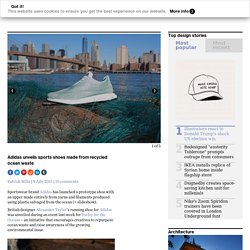
British designer Alexander Taylor's running shoe for Adidas was unveiled during an event last week for Parley for the Oceans – an initiative that encourages creatives to repurpose ocean waste and raise awareness of the growing environmental issue. Taylor constructed the Adidas x Parley shoes using the brand's existing footwear manufacturing process, but replaced the yarns with fibres made from waste plastic and fishing nets.
"This way there is no reason why materials with similar characteristics to those that we use every day with conventional production processes cannot be simply replaced by ocean plastic materials," Taylor told Dezeen. Taylor's design for the trainer places a white upper, patterned with contours of green stitching, on top of Adidas' boost sole. Adidas revealed the designs during a talk titled "Oceans. HOME - FORWARD THINKING ARCHITECTURE. Monitor: Re-cycling. Alice Bows-Larkin: Climate change is happening. Here's how we adapt. Stella McCartney’s fake-fur coats are worlds away from the brutal fur trade. In an industry where designers rarely take an admirable position on anything, Stella McCartney’s opposition to animal cruelty has been consistent and vocal.
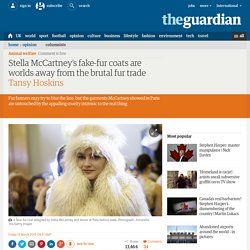
So it was a surprise for the fashion press when she sent voluminous fake-fur coats down the runway at Paris fashion week. Of her decision, McCartney said: “I’ve been speaking to younger women about it recently and they don’t even want real fur. So I feel like maybe things have moved on …” Sustainable Development Overview. The World Bank Group integrates the principles of sustainable development into its work with clients across all sectors and regions.
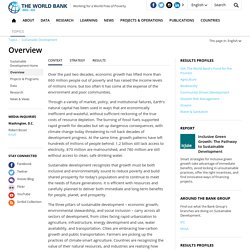
Those principles are also at the heart of the World Bank Group’s mission statement released in 2013 and are aligned with its overarching goals to end extreme poverty and promote share prosperity: “Ending extreme poverty within a generation and promoting shared prosperity must be achieved in such a way as to be sustainable over time and across generations. This requires promoting environmental, social, and fiscal sustainability.
We need to secure the long-term future of our planet and its resources so future generations do not find themselves in a wasteland. How can the fashion industry become more sustainable? Pure Waste Textiles - Sustainable Fashion Evolution - Nordic Style Magazine. Sustainability is more than just avoiding waste, it is about creating from it, this is the premise behind Pure Waste Textiles a young Green Company from Helsinki, Finland founded in 2013.
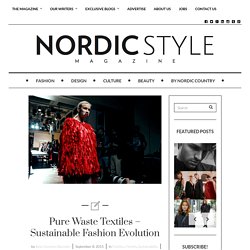
Pure Waste creates its fabrics in its own factory recently opened in India and they are at the forefront of the Sustainable Evolution as they produce textiles out of 100% recycled materials, yes over 100,000 products made of 100% recycled materials up to date. The Helsinki based textile company is pushing boundaries on what being green is, they are not compromising quality as their fabric made out of recycled materials can easily compete with virgin textiles in quality. Hannes and Anders Bengs along with partners Lauri Köngäs-Eskandari and Jukka Pesola have not only started a sustainable phenomenon in the Finnish fashion scene but have made waves in the tech industry as they make merchandise for tech giants such as Supercell, Rovio and F-Secure. H&M on Conscious Materials. Detox: How People Power is Cleaning Up Fashion.
Wearable pineapple fibres could prove sustainable alternative to leather. At weddings and formal events in the Philippines, men can often be seen wearing the Barong Tagalog, a thin and transparent embroidered garment worn over a shirt.

One of the more surprising materials used in its manufacture are fibres from pineapple leaves – and long strands of the leaves could soon also be used to make a host of other products, from trainers and clothes to bags and car upholstery. Called Piñatex - piña is Spanish for pineapple - the new material was created by Carmen Hijosa, who worked as a consultant in the Philippines leather goods industry in the 1990s. She was unimpressed with the standard of goods produced and started to look for alternatives. Raw for the Oceans « Ecouterre. Bionic Yarn estimates that the full collection employs an estimated 10 tons of recycled marine debris.
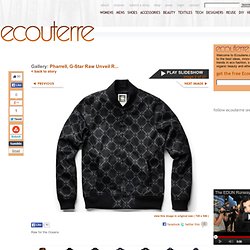
The line, which includes T-shirts, hoodies, boilersuits, trench coats, bomber jackets, jeans, and baseball caps in dark blue and black, features subtle detailing, plus original motifs based on its “Otto the Octopus” logo. RELATED | Pharrell, G-Star Raw Create Denim Made From Recycled Ocean Plastic Raw for the Oceans will be available for men and women in September, but it’s already making an impression. The Cannes Lions jury awarded the line with the Grand Prix for its inaugural product-design category. “The end result was the clothing itself,” U.S. judge Dan Formosa, a designer at Smart Design, told Ad Age. Young Entrepreneur Of The Week: Tom Cridland, Who's Making Sustainability Trendy With His 30-Year Jumper. Tom Cridland isn't afraid of a challenge.

The 24-year-old founded his eponymous menswear brand last year and set himself the mammoth task of making, quite literally, the perfect pair of pants. Now, the young entrepreneur has his sights on sustainability - and has created The 30 Year Sweatshirt, which, rather tellingly, comes with a 30 year guarantee. Designer Tom Cridland "I decided to create it as I firmly believe that built-in obsolescence in the 'fast fashion' industry is wrong and unnecessary," he tells The Huffington Post UK. Sustainability. Fashion vs climate change. "It's an information war," trailblazing writer Naomi Klein told journalists at a recent oil pipeline protest in her native Canada.
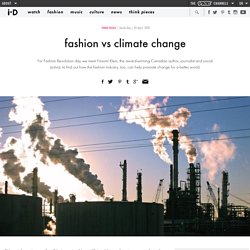
"There's no doubt that it's an information war and we're up against the richest industry in history. " Indeed. It's blindingly clear that Klein's new, illuminating book, the deeply researched yet accessible This Changes Everything: Capitalism vs the Climate, neatly fills a massive information gap. Will transparency in the fashion industry ever become a reality? Ethical fashion's movers and shakers met at the Ethical Fashion Forum's SOURCE Summit last Friday.

Calling itself "the most important event for fashion and sustainability", this was a one-day industry convention held at The Crystal in London. It was a day where people working in the ever-growing ethical fashion ghetto could network and discuss the issues that colour the sector. As with any growing field, the future was discussed and debated at length along with the sustainability of sustainability, how to hit the mass appeal zeitgeist and, crucial to all this progress, transparency.
Like most things fashion, buzzwords abounded. "Ethics". The Centre for Sustainable Fashion provokes, challenges and questions the fashion status quo. Through collaboration we design transforming solutions that. Why aren't fashion journalists doing more to address the industry's role in climate change? We've entered the age of bottom-lines; and the bottom line for corporate fashion brands is that their business model is now incompatible with our survival on planet earth. The last walking expeditions to the North Pole are being made as the ice has become too thin to traverse, and our energy consumption has led to new, extreme forms of fossil fuel extraction in the Canadian tar sands and Arctic.
The fashion industry has had 20 years to self-regulate but now, the door to keeping the planet within the +2 degree temperature rise, a figure universally accepted to be safe for human life, begins closing in 2017 and the textile and garments industry is responsible for at least 10% of those carbon emissions. So, what's happening? In 2015, instead of using the Rana Plaza tragedy in Bangladesh as a wake-up call, brands are moving factories to Ethiopia where there are no laws on minimum wage and few on emissions. Fashion editors don't ordinarily mix with climate scientists. Trashion. The 2009 Fashion Trashion show at the University of Minnesota, Morris featured outfits created from trash and recycled materials Trashion (a portmanteau of "trash" and "fashion") is a term for art, jewelry, fashion and objects for the home created from used, thrown-out, found and repurposed elements.
The term was first coined in New Zealand in 2004[1] and gained in usage through 2005.[2] Trashion is a subgenre of found art, which is basically using objects that already have some other defined purpose, and turning it into art. The ethics of fake fur. Fake fur is a political statement as much as a fashion statement. When a celebrity or friend wears it, you can't help making some assumptions: She's the kind of person who cares about animals, sure, but maybe also gets her Shiba Inu massages, drinks $12 juices, and takes vacations in solar-powered yurts. In other words, fake fur is part of a (cruelty-free, artisanally flavoured) lifestyle espoused by those who claim to prioritise ethics and aesthetics. Should it be? This Thai Fashionista Makes Fierce Outfits From Everyday Objects. A fierce figure has descended upon our Instagram feeds, and he calls himself ThaiBan Fashionist, or Thai Fashionista. The 15-year-old boy is quickly becoming a social-media sensation for his incredible creativity and artistic vision in fashion.
The young designer creates outfits from everyday objects, like hangers, leaves, and woven baskets, taking them from ordinary to high fashion with a series of fabulous poses and intense expressions. It's clear the Thai Fashionista loves to experiment with everything he can get his hands on, and whatever he touches becomes instantly chic. When scrolling through his feed, it's easy to see that he has a knack for styling, and we have no doubt his obvious love for fashion and creativity will take him very far. Los Angeles garment industry violations “alarming” While most allegations of factory worker abuses focus on Asia, an “alarming” number of health and safety violations are also occurring in Los Angeles' garment industry, a new report has found, including physical violence and sexual harassment.
The three month survey carried out by the Garment Worker Center, interviewed 175 workers in Los Angeles County's garment district between June and August 2015. The workforce, the report explains, is largely made up of low-income immigrants who are “routinely exploited, underpaid, and work under sweatshop conditions”.